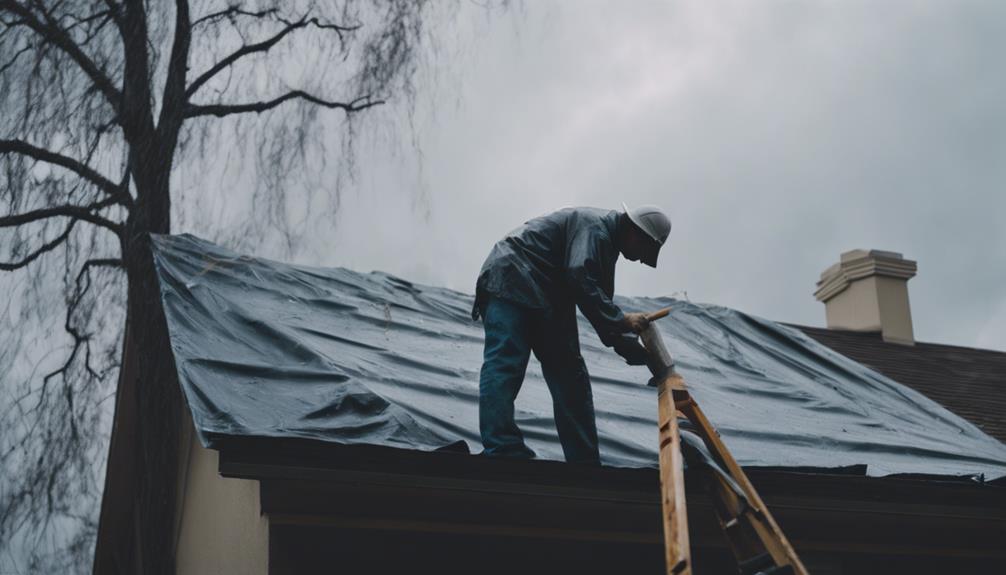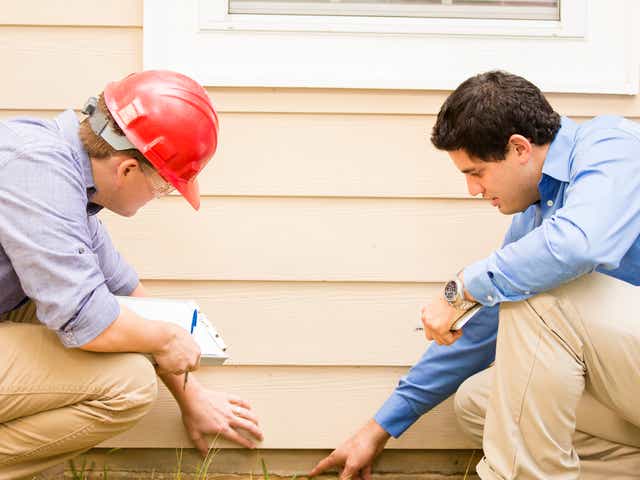
When it comes to addressing urgent roof repairs in San Jose, envision this scenario: a sudden storm leaves your roof vulnerable, and you need a solution fast. Imagine having the knowledge to handle common issues swiftly before the professionals arrive. From sealing leaks to securing shingles, these immediate actions can make a significant difference in safeguarding your home. But what other essential tips could help you weather the storm until expert help arrives?
Roof Leak Patching
When encountering a roof leak, promptly apply a waterproof patch to guarantee no further damage. Start by locating the source of the leak; it may not always be directly above where the water is dripping into your home.
Once you’ve identified the spot, clean the area thoroughly to secure proper adhesion for the patch. Use a patching material specifically designed for roofs, such as roof cement or roofing sealant, and apply it generously over the damaged area. Press down firmly to seal the patch in place and prevent any water from seeping through. Make sure the patch extends beyond the damaged area to provide extra protection.
After applying the patch, monitor the area closely for any signs of additional leaking. Remember that this patch is a temporary solution and should be followed up with a more permanent fix. If the leak persists or worsens, consider contacting a professional roofer to assess and repair the damage properly.
Taking quick action to patch up a roof leak can help prevent costly repairs and further water damage to your home.
Shingle Securing
To secure shingles effectively, make sure they’re properly aligned and firmly attached to the roof surface. Inspect the shingles on your roof for any signs of damage or looseness. If you notice any shingles that are out of place or appear to be lifting, it’s important to secure them promptly to prevent further water infiltration.
Start by gently lifting the edges of the loose shingle and applying roofing cement underneath. Press the shingle back into place and secure it with roofing nails or screws for added stability. Be sure to space the fasteners appropriately to guarantee a secure fit without causing damage to the shingle.
Regular maintenance of your roof, including checking and securing loose shingles, can help prevent more extensive damage during inclement weather. By addressing shingle issues promptly, you can maintain the integrity of your roof and protect your home from leaks and water damage.
Tarp Installation
Consider using a heavy-duty tarp to quickly cover and protect any areas of your roof that have been damaged or compromised. Securing a tarp over the damaged section can help prevent further water intrusion and protect your home from additional harm until a more permanent solution can be put in place.
To install the tarp, start by carefully measuring the damaged area to make certain the tarp will adequately cover it. Use a tarp that’s specifically designed for roofing purposes and make sure it’s large enough to overlap the damaged section by at least a few feet on each side. Secure the tarp tightly using strong ropes or bungee cords to prevent it from being lifted by the wind.
When securing the tarp, pay special attention to the edges and corners to guarantee a tight fit. If possible, tuck the edges under undamaged sections of the roof to provide extra protection. Regularly check the tarp for any signs of loosening or damage, especially after severe weather conditions. Remember, while a tarp is a temporary solution, it can offer valuable protection for your home during emergencies.
Gutter Cleaning
Make sure your gutters are free from debris by regularly cleaning them to prevent water damage to your home. Neglected gutters can lead to water overflowing and seeping into your home, causing damage to the roof, walls, and foundation.
To maintain your gutters in good condition, follow these simple steps:
– **Remove Debris:** Clear out leaves, twigs, and any other debris that may have accumulated in the gutters.
– **Check Downspouts:** Make certain that downspouts aren’t clogged and are directing water away from the foundation.
– **Inspect for Damage:** Look for any signs of damage such as rust, holes, or loose brackets, and repair them promptly to prevent further issues.
Regular gutter cleaning is a quick and easy way to prevent costly water damage to your home. By taking the time to maintain your gutters, you can protect your property and ensure that rainwater is properly diverted away from your home.
Flashing Repair
Regular maintenance of your gutters can help prevent water damage. Now, it’s essential to address any issues with your flashing to ensure your roof remains watertight.
Flashing is the material installed around roof features like chimneys, skylights, and vents to prevent water from seeping into the roof. Damaged or improperly installed flashing can lead to leaks and extensive water damage inside your home.
To repair flashing, start by inspecting it for any signs of damage such as cracks, rust, or loose sections. If you notice any issues, you can use roofing cement to seal small cracks or holes. For more extensive damage, it’s best to call a professional San Jose roofing company to replace the flashing properly.
Remember that proper flashing installation is vital to maintaining a watertight roof and preventing costly repairs in the future.
Chimney Inspection
Inspect your chimney for any signs of damage or wear to guarantee its structural integrity and prevent potential hazards. Start by looking for cracks, loose bricks, or missing mortar that could indicate a problem. Make sure that the chimney cap is in good condition and securely attached to prevent water infiltration and debris entry. Addressing any issues promptly is crucial to avoid costly repairs or safety risks.
Here are some key points to keep in mind during your chimney inspection:
– Check for cracks or gaps in the chimney bricks or mortar.
– Confirm that the chimney cap is intact and free of any damage.
– Look for signs of water stains or leaks around the chimney area.
Regular maintenance and timely repairs can help extend the lifespan of your chimney and prevent more significant issues down the line. By staying proactive, you can ensure a safe and functional chimney for years to come.
Attic Ventilation Check
Maintaining proper attic ventilation is crucial for sustaining a healthy and efficient home environment. Sufficient ventilation helps regulate temperature extremes, prevent moisture buildup, and prolong the lifespan of your roof.
To check your attic’s ventilation, start by examining the soffit vents along the eaves of your roof. These vents allow fresh air to enter the attic space. Confirm they’re clear of any debris or obstructions that could hinder airflow.
Next, inspect the ridge vents or gable vents situated at the top of the roof to allow hot air to escape. Ensure these vents are also free from any blockages such as bird nests or leaves. Additionally, consider installing attic fans to enhance air circulation if necessary.
Proper attic ventilation not only safeguards your roof but also improves the overall comfort and energy efficiency of your home. Regularly inspecting and maintaining your attic ventilation system can help prevent costly repairs in the long run.
Tree Limb Removal
To safeguard your roof from potential damage and guarantee safety, consider promptly removing any tree limbs that pose a risk of falling onto your home. Tree limb removal is vital in preventing costly roof repairs and ensuring the well-being of your household. Here are some quick tips to help you tackle this task effectively:
– **Assessment:** Start by evaluating the trees around your property to identify any overhanging limbs that could potentially fall during a storm or strong winds.
– **Trimming:** Trim back branches that are close to or touching your roof. This proactive approach can greatly reduce the risk of branches breaking off and causing damage.
– **Professional Help:** For larger limbs or trees close to your home, consider hiring a professional tree service. They have the expertise and equipment to safely remove hazardous limbs without causing further damage.
Conclusion
To sum up, implementing quick action with emergency roof repairs in San Jose can help prevent further damage to your home.
By addressing roof leaks, securing shingles, and installing temporary tarps, you can protect your property while waiting for professional assistance.
Don’t forget to maintain gutters, repair flashing, and check attic ventilation for ideal roof health.
Stay proactive and keep your home safe and secure with these quick fixes.



